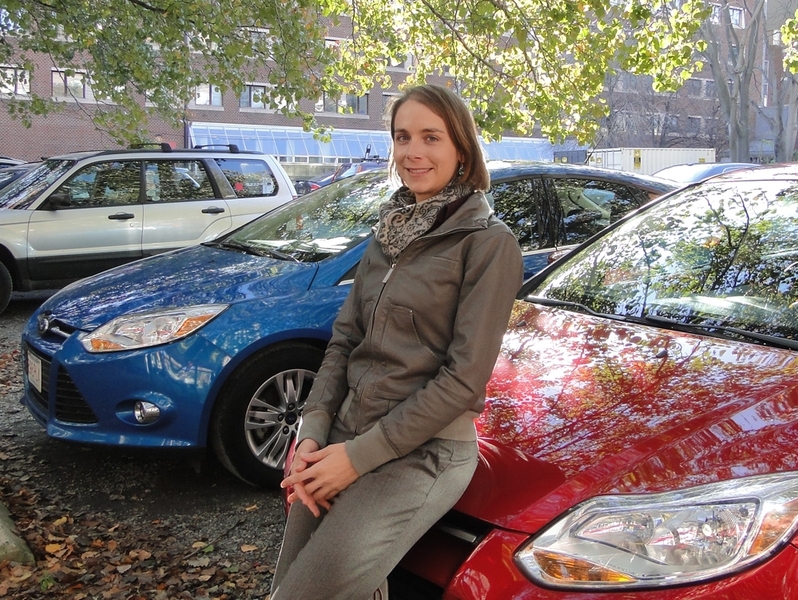New standards to strengthen vehicle fuel efficiency are considered one of the landmark environmental achievements of President Obama’s first term. Passed with the backing of automakers and autoworkers, the measure has been touted as a way to save consumers more than $1.7 trillion at the pump and cut carbon emissions from passenger vehicles in half. While the standards have many good merits, a more effective approach might be an economy-wide carbon tax, say researchers at MIT’s Joint Program on the Science and Policy of Global Change.
The researchers look at the full energy and economic impacts of the efficiency standards, which in their finalized form now require automakers to install pollution-control technology to improve the fuel efficiency of cars by 5 percent and light trucks by 3.5 percent with each new model year starting in 2017. Published this month in the journal Transportation Research Record, the study won this year’s Pyke Johnson Award for the best paper in the area of planning and the environment.
“Common thinking in Washington holds that any policy that seems to advance technology without creating new taxes must be a no brainer for the country. That misses the broader economic impact,” says Joint Program Research Scientist Valerie Karplus, the lead author of the study. “As my colleague says, you may see more money in your front pocket at the pump, but you’re financing the policy out of your back pocket through your tax dollars and at the point of your vehicle purchase.”
Instead, Karplus says a gasoline or carbon tax makes more sense economically by providing consumers a direct incentive to either reduce their driving or buy more efficient vehicles.
“From an economic perspective that’s very clear, but from a political feasibility perspective it’s very different,” she says. Unlike fuel standards that hide the true costs, “a tax on gasoline has proven to be a nonstarter for many decades in the U.S., and I think one of the reasons is that it would be very visible to consumers every time they go to fill up their cars.”
The one hope, Karplus and some of her colleagues at the Joint Program say, is that in the midst of deficit talks a tax on carbon emissions might be considered to help raise the money needed to slash the deficit and avoid some tax hikes and spending cuts. The program published a study in August that looked at the effectiveness of this approach. That study showed that with a carbon tax the economy could overall improve, other taxes could be lowered and pollution emissions would be reduced.
“Congress will face many difficult tradeoffs in stimulating the economy and job growth while reducing the deficit,” says John Reilly, the co-director of the Joint Program and an author of the carbon tax study. “But with the carbon tax there are virtually no serious tradeoffs.”
Conversely, when Karplus and her colleagues simulated the proposed fuel economy standards, they found that while drivers of these more efficient vehicles will likely save at the pump, they could on average spend several thousands of dollars more when buying their new car, consistent with EPA estimates. Even more troubling, diverting efforts toward improved vehicle efficiency distorts overall economic activity, adding to the indirect cost of the policy.
Estimates of how costly the policy would be — in terms of both direct costs to consumers and the larger rippling costs to the economy — hinge on the relative cost of the technology and other strategies available to improve efficiency. The shorter the time frame automakers have to develop the technology and produce more efficient vehicles, the less time there will be for technological progress and other factors to drive down costs — such as the cost of batteries — and the more consumers will need to pay upfront. Emissions and oil imports will initially drop, both due to increased fuel efficiency and as the higher vehicle costs weigh on consumer budgets. But as consumers face lower costs per mile traveled, they may drive more, offsetting reductions in emissions and oil imports.
Karplus hopes her results will help policymakers make more informed decisions going forward. She credits that to the innovative — and award-winning — method she used, which weaves engineering and technology constraints into a broad economic framework and allows researchers to test the cost and other impacts of a policy at different levels of stringency. This method inherently takes account of life-cycle emissions as well as impacts that transmit across fuel markets by affecting prices.
For example, a policy might only consider gasoline use by plug-in electric hybrids. But that “tailpipe measure” doesn’t take into account the emissions created from building, transporting and recharging those batteries. Her approach does.
“There are a lot of hidden costs to a policy like this,” Karplus says. “This model doesn’t allow you to ignore other important aspects of the economy and energy systems. It requires you to be explicit about your technology and cost assumptions. It provides a framework that allows lawmakers to look at all the available information on costs and the state of the technology and decide how to best create or update policies.”
Of this approach, University of Maine environmental economist Jonathan Rubin, says “The research of Dr. Karplus on the energy and climate impacts of the nation’s fuel economy standards for our cars and trucks makes an important contribution to policymaking based on science.”
Rubin is the chair of the Transportation Energy Committee of the Transportation Research Board, which will honor Karplus with the Pyke Johnson award at a ceremony in January.
MIT researchers show merits of a carbon tax.
Publication Date:

Caption:
Valerie Karplus, a research scientist with MIT's Joint Program on the Science and Policy of Global Change





